|
|
|
The Legendary Pilot Murex
This article was first published around 2003 and last updated in 2021) This was no ordinary pen. This was the ultimate modern fountain pen. You could carry it everywhere, travel with it, sit on it, toss it in your bag, knock it around, and it would never fail you. This was the pen you'd want to grab as you went out the door. And this was the pen most likely to grab everyone's attention when you whipped it out to jot a note. 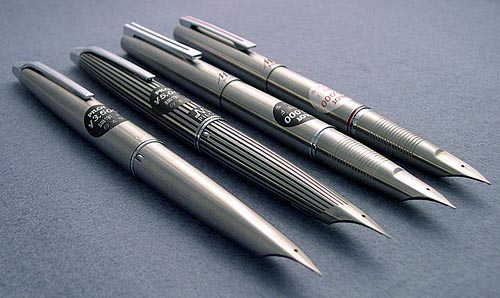 This was the Pilot Murex, the famous stainless steel pen with the integral nib produced by Pilot during the 70's and early 80's. It is pronounced in Japanese, "MYU-REX". The first two short models were actually named "MYU" by Pilot. The later models full size models were called Murex. These were two distinct pen lines, although related. While western pen collectors lump both of these together under the Murex banner, most Japanese collectors do just the opposite and refer to both groups as "MYU" pens, short MYUs and long MYUs. 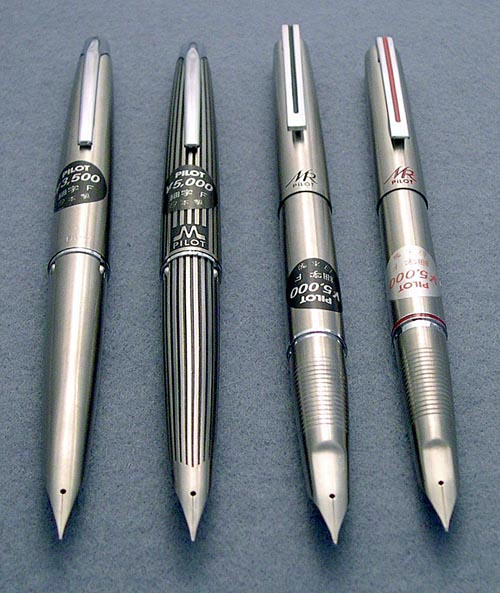 Pilot MYUs and Murexes were only sold here in Japan, intended for the Japanese market, which explains why they are so highly valued in the west. Even in Japan they are impossible to find since Pilot no longer makes them. But they are such tough pens, the ones that do turn up are usually still in great condition. These are workhorse pens. Seeing their popularity today, it's an amazing fact that Pilot stopped making these pens so long ago. I asked Pilot pen craftsman Mr. Hirosawa if they ever considered making these pens again. He acknowledged their popularity right now but smiled and shook his head "no" at the suggestion. Note added later: Pilot did finally produce a new limited edition MYU in 2008 called the M90. Apparently the big wigs noticed the renewed popularity of this pen (sparked by somebody's web article perhaps?). 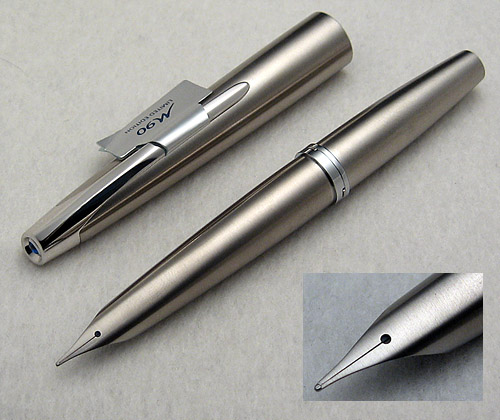 The design of the M90 differs in a few places from the original MYU 701. On the new version there's the name M90 on the clip and a blue artificial stone in the end of the cap. It reminds me of the Parker T-1 which had a ruby "stone" in the same place. The clip design is also a bit different from the original which shared a clip design with the Capless pens of that era. Unfortunately, in a matter of months, the M90 sold out and became as impossible to find as the original MYU 701! They are often compared to the titanium Parker T-1 pen which was introduced in 1970 just before the Pilot MYU came out, and was produced for only one year. 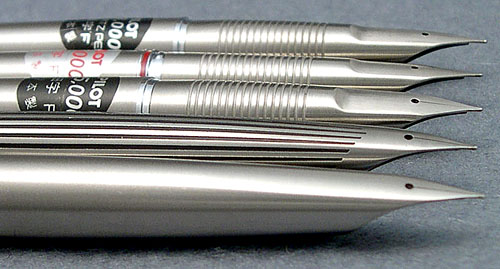 The design of the Pilot MYU was inspired by the original quill pens of a former age. The unbroken countour from the fingers to the tip of the nib on the MYUs -- and the subtle contour on the Murexes -- do make for a more natural, more intuitive experience in writing and drawing.  The photos in this article feature the pens with their original price stickers. The stickers are informative, but they do take away from the beauty of the pen! Some came with price tags instead of stickers, and it has been said that the tags were from earlier models. But the date stamps on the pens themselves indicate that there is no relationship between tags, stickers, and dates of manufacture. 1971 Original MYU 701
  The first Murex appeared in 1971, and was called the "MYU 701" in Japanese and identified by the Greek letter for "m" in Pilot's advertisements. Its model number is M-350SS. This pen is displayed in the Pilot Pen Museum (now called "Pen Station") in Tokyo. This one of those ingenious Japanese short style pens with long cap and short barrel that made the pen short when capped, and full size when the cap was posted. It was an extremely streamlined design with no markings anywhere except for the small Pilot name engraved on the cap. There is also a tiny date stamp with month and year on the barrel. The first Murex appeared in 1971, and was called the "MYU 701" in Japanese and identified by the Greek letter for "m" in Pilot's advertisements. Its model number is M-350SS. This pen is displayed in the Pilot Pen Museum (now called "Pen Station") in Tokyo. This one of those ingenious Japanese short style pens with long cap and short barrel that made the pen short when capped, and full size when the cap was posted. It was an extremely streamlined design with no markings anywhere except for the small Pilot name engraved on the cap. There is also a tiny date stamp with month and year on the barrel.
This model is considered the quintessential MYU/Murex, and therefore the most famous model today. It has also been called the "ultimate travel pen" because of its small carrying size as well as its sturdiness and reliability. It retailed for 3,500 yen when it first came out in the 1970's, but an original MYU with price sticker (identical to the one in the photo) was sold 30 years later on an internet auction for over 500 dollars. The market value of all the MYU/Murex models increased dramatically as more collectors showed interest in them. 1973 Black Striped MYU
 In 1973 a black striped version appeared, also a short type pen. Its model number is M-500BS. The letter "M" (for "MYU") plus the Pilot name was stamped on the cap. The black enamel stripes are recessed, away from exposure to rubbing. The finish was brushed steel. It retailed for 5,000 yen. Elusive White Striped MYU

1977 Long Murex
 In 1977 the integral nib steel pen was radically redesigned to be a full sized pen with textured section, flat nib and black stripe in a spring type clip that adjusted to any thickness of pocket fabric. This model was the first "Murex" pen. Perhaps this new name was meant to designate this bigger, improved MYU as the king (Rex) of the MYUs. It could also be a reference to the sea shell of the same name. Its model number is MR-500SS, and it is also displayed in the Pilot Pen Museum (Pen Station) in Tokyo since it represents a new line. On the cap the black letters "MR" (for "MYU-REX") plus the Pilot name are engraved. It retailed for 5,000 yen, much more than the price of the original MYU 701, and its design was technically superior to the original MYU, although not as radical in its looks. This model was designed for comfort and effortless writing. 1978 Red Trim Long Murex
 In 1978 Pilot came out with a slim, slightly shorter version of the long type Murex, this time with a red stripe and logo. It retailed for 5,000 yen. 1981 Clock Murex
 The above Murex pens were introduced during the 70's. There was one more Murex that was introduced in 1981. Its model number was FDW800S, and it retailed for 8,000 yen. This was an interesting model with a quartz clock right on the cap. Under the MR logo on the cap is the word QUARTZ. The MYU/Murex Extended Family
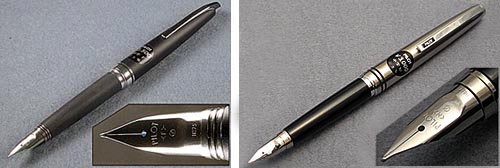 Pilot also produced during the same period, pens which were nearly identical to the MYU 701, but with the nib separate from the barrel. One line was marketed as the plastic MYU, and had a matte black cap and barrel. Other colors were also available. A steel version of this was called the Volex, the "Brother of MYU." There were also some steel and plastic fountain pens which resembled the long Murex except for a brightly colored plastic grip separating the steel nib from the barrel. These variations are appealing to those who are drawn to the asthetics of the MYU/Murex design. Dating a Murex
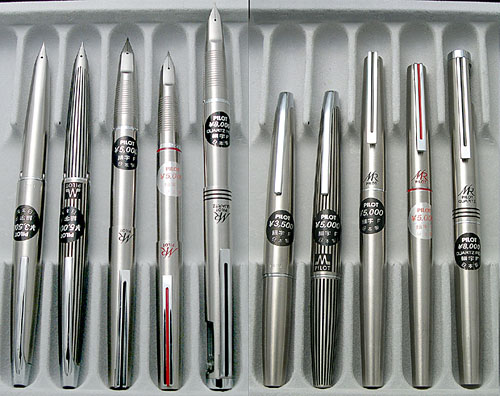 Comparative lengths of the MYU/Murex lineup, uncapped and capped From left: MYU 701, Black Striped MYU, Long Murex, Red Trim Long Murex, Quartz Clock Murex. Happy Murex or MYU owners
Here are a few comments which have I have extracted from e-mails sent to me by Murex or MYU owners in the past. I have omitted most of the names to protect their privacy.
|
|
The Pilot Murex pen was delivered today and it looks great and works great. I had this pen in the 70's, using it every day at work, and then lost it in the early 80's and spent the last decades trying to find a pen I liked as much. It's a nicer piece than I remember. Thanks again. The Pilot Myu 701 arrived today. The look and feel are just what I had hoped. The fine nib makes a wonderful thin line. I gave up on fountain pens a few years ago because the line was too thick and the ink bled or feathered. This writes beautifully in my Moleskine journal and sketches well in the Moleskine watercolor notebook. I'm delighted with it! I gave a presentation to a group of executives and used the Myu as an example of True, Good, Beautiful and Simple. Several people asked me more about it afterwards. One wants to get one for her husband. I gave her your contact information. I would like to thank you for introducing me to this awesome pen. I really enjoy it. Though I got to admit that the design first got to me, the feel and the actually use, absolutely did it for me. It's a beautiful pen. I just received my MYU 701 from you. I LOVE THIS PEN! Each pen is great, but this one is the BEST I own. I am so excited about it. HI! just to say I bought this model in 1975, in a penstore, and it is still working and it is still very pleasant to look at, giving a kind of smooth feeling in mind and in touch as well, due to its line and the texture of its brushed steel "skin". As a teacher I have written kilometers of courses with it, and I can say better call it M standing for Mega than μ standing for micro. Hope your purchasers will have lot of pleasure to write with as I had and still have. JL MORRA (France) The Murex pen has arrived and is stunning! I must tell you, I own about 40 fountain pens and the Murex are my hands down favorites. re: MYU 701: What a pleasant surprise! The Myu is fantastic...the best pen I've written with (and my collection used to be quite large) so the one you sent me is safely in my pocket and I want another one to put away as a backup. I have learned that when one has a valuable tool, one should have a backup. Pilot was crazy to stop making them. the murex is one of the still undervalued collectors pens At work I use a rotation of fountain pens and find the Japanese ones I have bought from you over the last few months have quite a unique feel. Different to the US and European ones. I particularly like the little Myus. Tough compact and firm. I love the Murex I bought...It's my daily pen |
|
A note about stainless steel and scratches
Stainless steel Japanese fountain pens such as these MYUs and Murexes tend to come with tiny scratches. I have rarely seen one without scratches, especially on the barrel of pocket pens. This is because of the metal piece inserted into the cap which grips the barrel and keeps it firmly attached to the cap by friction. As soon as they put the cap on a new pen, it receives a tiny scratch, the first of many. This also explains scratches on the barrels of brand new plastic pens. There is no need to be upset if you find scratches on your steel pen. If you look closely at the stainless steel surface you will see that it is brushed steel, which is basically a pattern of microscopic scratches covering the entire surface. Each scratch reflects light, so the more it's scratched, the more the pen sparkles. The longer you use your pen, the better it looks. You don't have to baby your MYU or Murex or any other stainless steel pen. |
|
MYU QUIZ: What's wrong with this photograph?

The mystery photo If you don't know the answer, then you may have big problems with your Pilot MYU or other Japanese pens! Many Japanese pen companies use a metal ring to connect the nib section with the barrel on their pens. The ring has threads on both ends, and one end is hidden in the nib section. It is supposedly is held in place by friction alone. However, most rings will unscrew from the nib section very easily. It looks so natural (as in the above photo), that you might not even notice it for years! I have even seen photos of pens on internet auctions with the ring misplaced!  The renegade ring On some slim models like the Murex, the misplaced ring stuck on the barrel will actually yank the ink cartridge from the nib section as you unscrew the barrel. You could have ink all over your hands and still not know why! You will think you have a flawed, worthless pen, when it is a very simple problem to fix. A more serious problem is that the little steel piece inside the nib section that clutches the cap is now exposed, and could pop out. And these are impossible to re-insert without the right tools because they are easily bent out of shape! If that threaded ring is loose, you can help it to stay put by twisting it back in firmly with your fingers. You can also add a few drops of glue or even nail polish to the part that threads into the nib section. Just make sure you have a clear understanding which part that is! If you don't remember which end goes in the section, the above photo will prove to be a valuable reference.  The proper configuration Here is the way your pen ought to look, with that threaded ring connected to the nib section. And they all lived happily ever after. |
|
Now Extinct
For several years I searched all over Japan for these pens and I sold quite a few in the past, mainly on eBay, but those days are long gone and I have given up selling pens. You may still be able to find a MYU or Murex pen on eBay if you are lucky. |